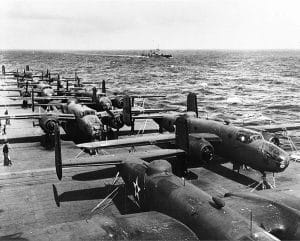As a child in Dayton, Ohio, Cole would ride his bicycle a few miles to the Army Air Corps test base at McCook Field to watch the pilots, including the legendary Jimmy Doolittle — and, of course, decided he wanted to be one too. He also read about pilots, and pasted stories in a scrapbook: “I remember reading about [John] MacReady, [Carl] Spaatz and Doolittle.” He joined the Army Air Corps thinking “it was a good job” for someone who came of age in the Great Depression, and received his pilot rating and commission as a lieutenant in July 1941 — just a few months before the U.S. was pulled into World War II by Japan’s bombing of Pearl Harbor. Not long after that, Cole saw a notice asking for volunteers for “a mission” — details unspecified. “Everyone wanted to go on that mission,” Cole said later, but few were chosen. The 26-year-old Cole was, and transferred to Eglin Air Field in Florida for special training. “We were confined to base, in isolated barracks, and told not to talk about our training,” Cole said in 2014. “We knew it would be dangerous, but that’s all.” The pilots’ first task: learn how to get their B-25 Mitchell bombers off the ground in 500 feet — it normally takes about 3,000 feet. Why? They’d be taking off from an aircraft carrier.

It wasn’t until the team was aboard the USS Hornet (CV-8) that they learned what their mission would be: to bomb mainland Japan — in daylight. The plan wasn’t to do significant military damage, but to give notice to Japan that just four months after Pearl Harbor, the U.S. was ready to fight back — and could reach their homeland. “We were pretty excited — above all, happy to know what we were going to do,” Cole said. But quickly, “things quieted down as people began to realize what they were getting into.” Extraneous equipment had been removed from the bombers to save weight — even their bombsights — to enable them to carry extra fuel: about 1,100 gallons, double the planes’ usual capacity.

On April 18, 1942, the 16 bombers each with a crew of five launched from the Hornet in the western Pacific. Cole was co-pilot on the lead plane, seated beside the mission commander: his childhood hero, Lt. Col. James Doolittle. The operation came to be known as the Doolittle Raid. The weather was rough, but the carrier had been spotted by a Japanese patrol ship and they knew it had radioed a warning to Japan. None of the pilots had ever taken off from an aircraft carrier before, but all made it into the air safely, and stayed at around 200 feet to avoid detection — they had no fighter escorts. After six hours of flight they made their bombing runs against military and industrial targets in Tokyo, Yokohama, Yokosuka, Nagoya, Kobe, and Osaka. None of the planes were shot down, but the crews knew they couldn’t return to the Hornet: it was too small to land a B-25, let alone 16 of them. The plan was to refuel in China, but because they launched early they knew they wouldn’t make it to the designated airfields. The pilot with the least amount of fuel decided to head to the Soviet Union, since otherwise he’d have to ditch in the East China Sea. The planes started running out of fuel after 13 hours of flight; the crews bailed out over China and were assisted by Chinese troops. (The B-25 that went to the Soviet Union landed safely, but its crew was held for more than a year.) Three of the 80 crewmen were killed during the bailout or crash landings; eight were captured by the Japanese.

Doolittle thought his raid had failed and would lead to his court-martial. Instead, he was awarded the Medal of Honor, and promoted two steps, to brigadier general. His men were awarded the Distinguished Flying Cross. Morale at home soared, Hollywood had a movie out about the raid by 1944 (Thirty Seconds Over Tokyo), and “Japanese naval forces were at a disadvantage from then on,” Cole said. They were heroes, then? No, Cole said: “I don’t think that the Raiders should be remembered any more than the millions of other people who took part in World War II.” Cole retired from the U.S. Air Force in 1967 as a Lt. Colonel; by then, he had earned two more Distinguished Flying Crosses and a Bronze Star. In retirement, he grew and sold citrus. Richard E. “Dick” Cole was the last of the surviving Doolittle Raiders. He died at his home in Comfort, Texas, on April 9, at 103. His memorial will be held at Joint Base San Antonio on the 77th anniversary of the raid, and he will be interred with full military honors in the Arlington National Cemetery.
